

Jon Clements, Author (unless otherwise noted) and Editor
Note: current (June 19) DD Base 43 BE accumualtion, Belchertown, MA = 1309
| Coming events | Degree days (Base 43 BE) |
| Apple maggot 1st catch | 1225-1661 |
| Codling moth 1st flight subsides | 1264-1821 |
| Lesser appleworm 1st flight subsides | 1002-1538 |
| Obliquebanded leafroller summer larvae hatch | 1038-1460 |
| Oriental fruit moth 2nd flight starts | 1257-1496 |
| Peachtree borer 1st catch | 801-1326 |
| Oriental fruit moth 2nd flight starts | 1257-1496 |
| Redbanded leafroller 2nd flight starts | 1209-1562 |
| White apple leafhopper 1st brood adults peak | 1162-1414 |
11-July, 2017 (Tuesday) Massachusetts Fruit Growers' Association Summer Meeting, Cider Hill Farm, 45 Fern Avensue, Amesbury, MA. 10 AM to 2:30 PM. Orchard tour followed by lunch and then brand new hard cider facility tour. Pesticide re-certification credit requested. Pre-registration is necessary, register here and for more information.
For more information and updates, see Upcoming Events
Key insect life cycle and management dates and preliminary McIntosh harvest date forecasts
Note: for 2017, we have four Massachusetts orchard locations subscribed to AR: Amherst, Belchertown, Deerfield, and Easthampton. The website for looking at AgRadar for these locations is: http://extension.umaine.edu/ipm/ag-radar-apple-sites/. What follows is the AgRadar summary for the Belchertown location.
Key Apple Scab Dates -- http://ag-radar.umext.maine.edu/MAmodel/MA-Belchertown-ScabDates.htm Date of 'Final' significant primary scab ascospore release is/was: May 25, Thursday 'Final' defined as best guess of 99+% cumulative ascospore release, and high probability that at least 95% of ascospores have been released. Secondary scab protection and scouting should continue until 2nd generation lesions from the season's final ascospore release have had time to begin appearing. 2nd generation lesions from the FINAL significant primary scab ascospore release have had time to begin appearing by: June 26, Monday.
Codling moth CM -- 1st generation, first sustained trap catch biofix date: May 16, Tuesday. Codling moth development as of June 20: 1st generation adult emergence at 90% and 1st generation egg hatch at 49%. In most orchards, insecticide targetted against plum curculio and apple maggot prevent codling moth damage. If targetted codling moth control is needed, key management dates are: 1st generation 3% CM egg hatch: June 10, Saturday, = target date for first spray where MULTIPLE sprays needed to control 1st generation CM; 1st generation 20% CM egg hatch: June 14, Wednesday, = target date where one spray needed to control 1st generation CM.
Dogwood borer DB -- First egg hatch roughly: June 22. Peak hatch roughly: July 27.
European red mite ERM -- Optimum monitoring period for 3rd ERM generation is: Friday, June 23 (nymphs hatched) to Wednesday, June 28 (egglaying starts for 4th generation)
Obliquebanded leafroller OBLR -- 1st generation OBLR flight begins around June 8, Thursday. Where waiting to sample late instar OBLR larvae is not an option (= where OBLR is known to be a problem, and will be managed with insecticide against young larvae): Early egg hatch and optimum date for initial application of B.t., Delegate, Proclaim, Intrepid, Rimon, Altacor, Belt, pyrethroid or other insecticide effective against OBLR (with follow-up applications as needed): June 21, Wednesday. Where waiting to sample late instar OBLR larvae to determine need for treatment is an option, or to check on results from earlier sprays: Optimum sample date for late instar summer generation OBLR larvae: June 30, Friday. If first OBLR late instar larvae sample is below threshold, date for confirmation follow-up: July 4, Tuesday.
Oriental Fruit Moth OFM -- 2nd generation OFM flight begins around: June 26, Monday. 2nd generation - first treatment date, if needed: July 4, Tuesday. 2nd generation - second treatment date, if needed: July 16, Sunday.
Redbanded Leafroller RBLR -- 2nd RBLR flight begins around June 26, Monday. Peak catch and approximate start of egg hatch: July 10.
San Jose Scale (SJS) -- 1st generation SJS crawlers appear: June 17, Saturday.
Spotted Tentiform Leafminer STLM -- 2nd STLM flight begins around: June 14, Wednesday. Rough guess of when 2nd generation sap-feeding mines begin showing: July 2, Sunday. Optimum first sample date for 2nd generation STLM sapfeeding mines is July 9, Sunday.
Preliminary McIntosh harvest date forecast -- Date to apply ReTain to delay first harvest for apples which without treatment would be ready for storage harvest on September 2 is from Saturday August 5 to August 12. Date to apply ReTain to delay maturity for 2nd, 3rd or 4th pick of those apples, without delaying start of harvest maturity, is from Saturday, August 19 to August 26. Begin measuring actual McIntosh starch-iodine index no later than Saturday, August 26. The Michigan formula estimates that non-spur McIntosh will reach starch index 4.0 and start the optimum harvest window for long term storage on Saturday, September 2. Using the Hudson Valley NY formula, McIntosh maturity is forecast to reach starch index 6.0 in Belchertown MA on Saturday, September 23.
Jon Clements
It might be kind of a short HF this week as I am feeling a little burned out, and it is quieting down a bit. That being said the weather has favored disease development, primary scab is showing up in younger, lightly sprayed trees (pict) and where fungicide coverage was not timeley this spring. Good luck on that if you have primary scab. You might be interested in that RIMpro shows a fairly scary picture for secondary scab:
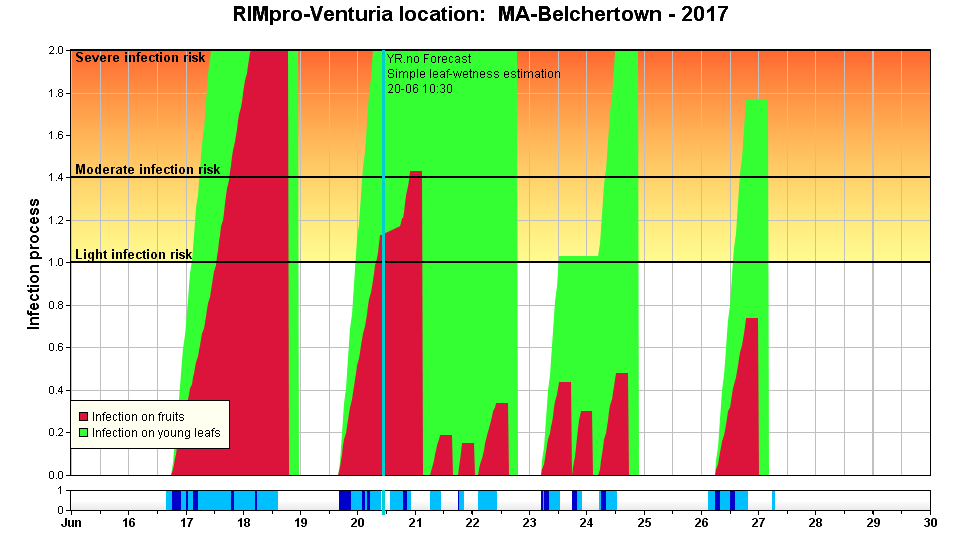
Oblique banded leafroller OBLR flight has peaked, we have caught copious numbers in our state-wide pheromone trapping network. See chart depiction below, cumulative OBLR trap capture date from 4 Massachusetts Counties. Orchards with a history of OBLR will need to apply an insecticide treatment soon.

Finally, this was a new one on me, but while hand-thinning a 4th-leaf block of Paul Friday peaches at the UMass Orchard we ran across this:
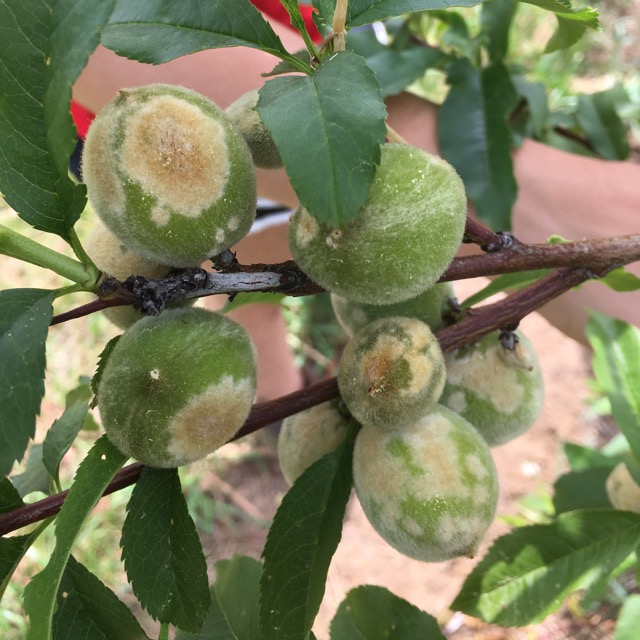
A pretty bad case of rusty spot on peach. It was clearly bad on one variety (PF-13 Lucky, pictured) and peach varieties are known to vary in susceptibility to the disease. Pretty much too late to do anything now except remove the afflicted fruit,and remember to spray FRAC 3 and/or 11 fungicides next year beginning at shuck split. Here is what Dan Cooley has to say about rusty spot after a little research (really, we are not too familiar with it, not having ever seem much/if any of it:
"Rusty spot is a disease that attacks young peach fruit. It is not an important disease problem in New England, though in southern New Jersey susceptible varieties may suffer real losses. The disease is caused by Podosphaera leucotricha, the same fungus that causes powdery mildew on apples. Rusty spot appears as white areas on green peach fruit, which later turn tan or brown, “rusty”. Peach plantings away near mildew-susceptible apple cultivars such as Ginger Gold, Cortland, Rome Beauty, or Idared, in orchards that have active mildew are more likely to get the disease. Some peach cultivars are much more susceptible, such as Autumnglo and Jersey Queen. Fruit become more resistant to rusty spot after pit hardening, but additional infections may occur after pit hardening if peaches are grown in an area with high levels of inoculum. If rusty spot is a consistent problem it can be controlled by applying fungicides that control powdery mildew starting at shuck split. Sulfur is probably the most cost-effective mildewcide for peaches, and the SI fungicides registered for controlling brown rot will also control rusty spot.
Elizabeth Garofalo (AKA Liz's Corner)
This week is a rogues gallery of miscellany, most of which is just interesting and less damaging. On the up side, I found one thing to give me a reason to remind you (or nag, as the case may be) to mow your orchards! Meet my new friend, Mormidea lumens, this stink bug is so uncommonly seen in crop plants that it doesn't even have a common name (and is not economically damaging). It is generally associated with grasses, but given the opportunity (like tall grasses in orchards) it will feed on crops. The one pictured below is now happily feeding on a bit of unripe peach.
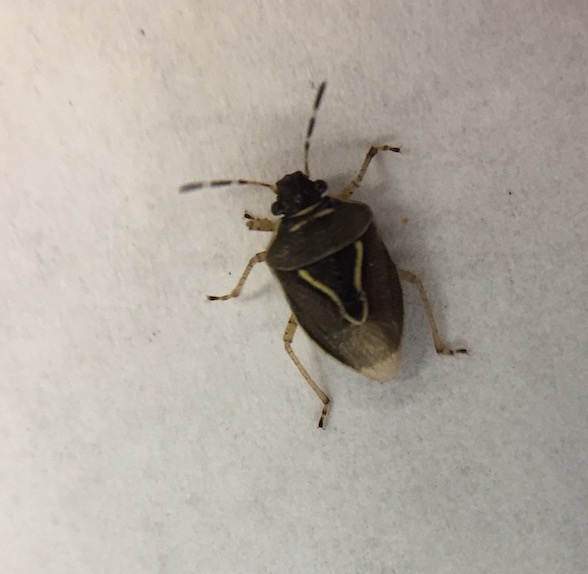
Next in the line up is the saddle back leafhopper. While this does have the potential to vector phytoplasmas, like all leafhoppers, it is, again, rare enough that it is not of economic concern. Unlike Potato Leafhopper, which has been out and about in orchards around the state for over a week now. Keep your eyes peeled for these little critters, especially if you have young plantings. Older trees can survive the damage while the stress on new plantings can cause serious harm.
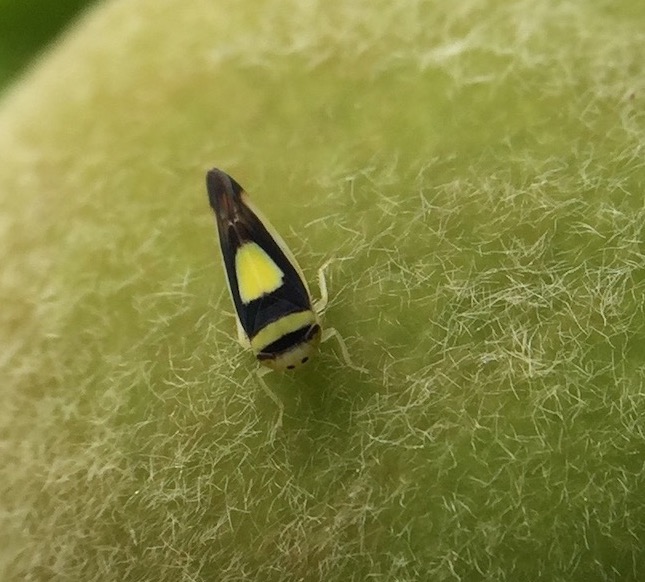
One other rarely seen insect also reared its exceptionally ugly head today: the apple leaf skeletonizer. In the average commercial orchard you are not likely to see this pest, or to have it do any damage. This particular larva was discovered in a low spray organic block. Should you come across any in your orchard, removing and destroying infested shoots is an adequate control measure.
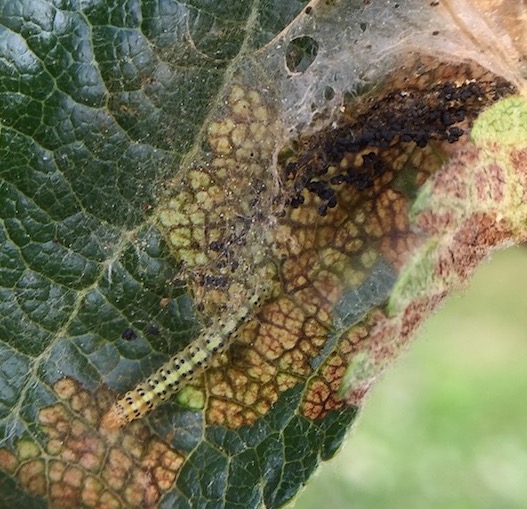
No tree fruit rogues gallery would be complete without a little apple scab action. If you missed any primary, lesions are showing up now on leaves and fruit.
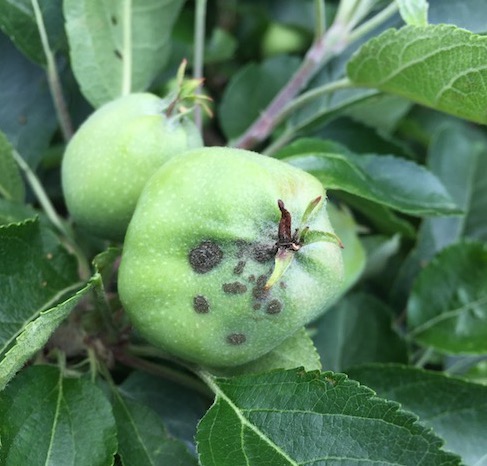
I do like to end on a positive note though, so, here are some spend soldier bug eggs for your enjoyment. Once these lovelies hatch out they will begin feeding on other (the pesky kind, mostly) stink bugs. (Ed. note: those got to be the coolest looking insect eggs I have ever seen, ala Transformers!)
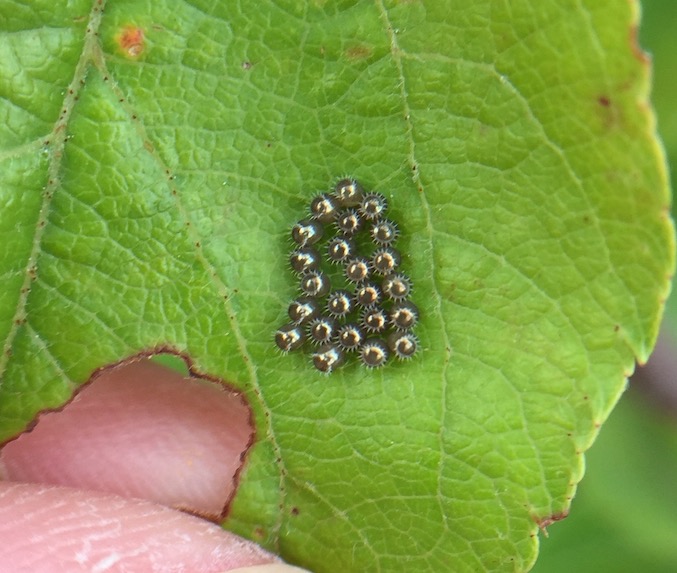
Dan Cooley
What we know and don't know about SBFS
1. In the Northeast, the FS fungi are the most important fungi in the SBFS complex because FS is more difficult to control than SB here.
2. Apples cannot be infected with SBFS until spores land on fruit, germinate and grow into the cuticle. Fruit need to be wet for long enough for that to happen.
3. If fruit are protected with scab fungicides at the end of primary scab, up through first cover, then SBFS spores will not infect until the fungicide breaks down or washes off.
4. If fruit is pubescent, meaning fuzzy, it’s harder for spores to land and infect the cuticle, meaning fruit skin. So very young fruit are less susceptible.
5. After germinating successfully, it takes some time for the invisible mycelia to grow and become visible as specks and blotches. How long this time is depends on how much wet, humid weather happens.
6. If appropriate systemic fungicides are applied some time before the fungi become visible, then fungal growth stops and no specks and blotches show up.
7. All this means there’s some time between the end of primary scab and the time established SBFS might start to show up that fungicide sprays aren’t needed.
The problem is we don’t know for sure how long the break in fungicide sprays is. Some say as short as 170 wet hours from petal fall. A solid week of wet humid weather gives that. Others say more like 270 to 350 hours from 10 days after petal fall, more like 10 to 14 days of wet weather starting over a week from petal fall. And we really have only a rough idea of how long fungicides last against SBFS, so our rules for fungicide loss are conservative. And these are just the unknowns we know about – there may be unknown unknowns! Anyhow, until we know a little more, it’s probably best to take a relatively short break between scab and SBFS. If primary scab was well controlled, and you have taken a two-week break from fungicide sprays, you probably have another week or so before it is time to start to control SBFS.
Jon Clements
Early last summer I treated (sprayed with a backpack sprayer) groups of RubyMac McIntosh/M.9-Pajam 2 that were whips from the nursery (Fig.1, 1st-leaf trees) with Maxcel at a high labeled rate of 400 ppm to induce branching on young trees. This year, the results are clearly visible -- untreated, 2nd-leaf trees have produced minimal numbers of branches (Fig.2), while Maxcel-treated trees have copious branching (Fig. 3). (Pardon the scab in those pictures.) The treatments were applied when the buds looked like this. So, if you have whips from the nursery, and want to get some branching, now would be a good time to treat. Note that the trees should be fertilized and irrigated for best results. Do not use any surfactant with Maxcel, and Exilis products (Fine Chemical, Inc.) should do the same job.
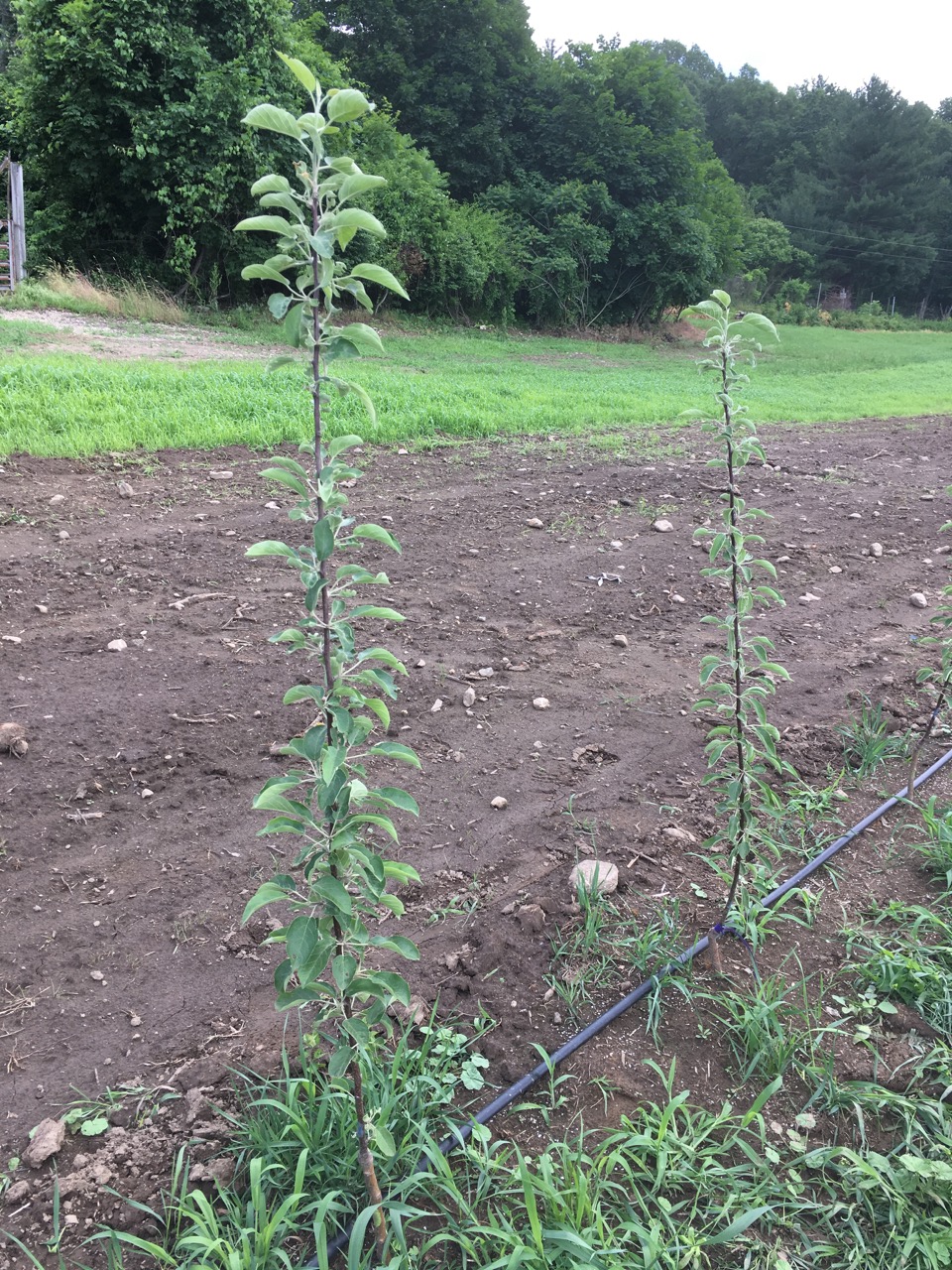 |
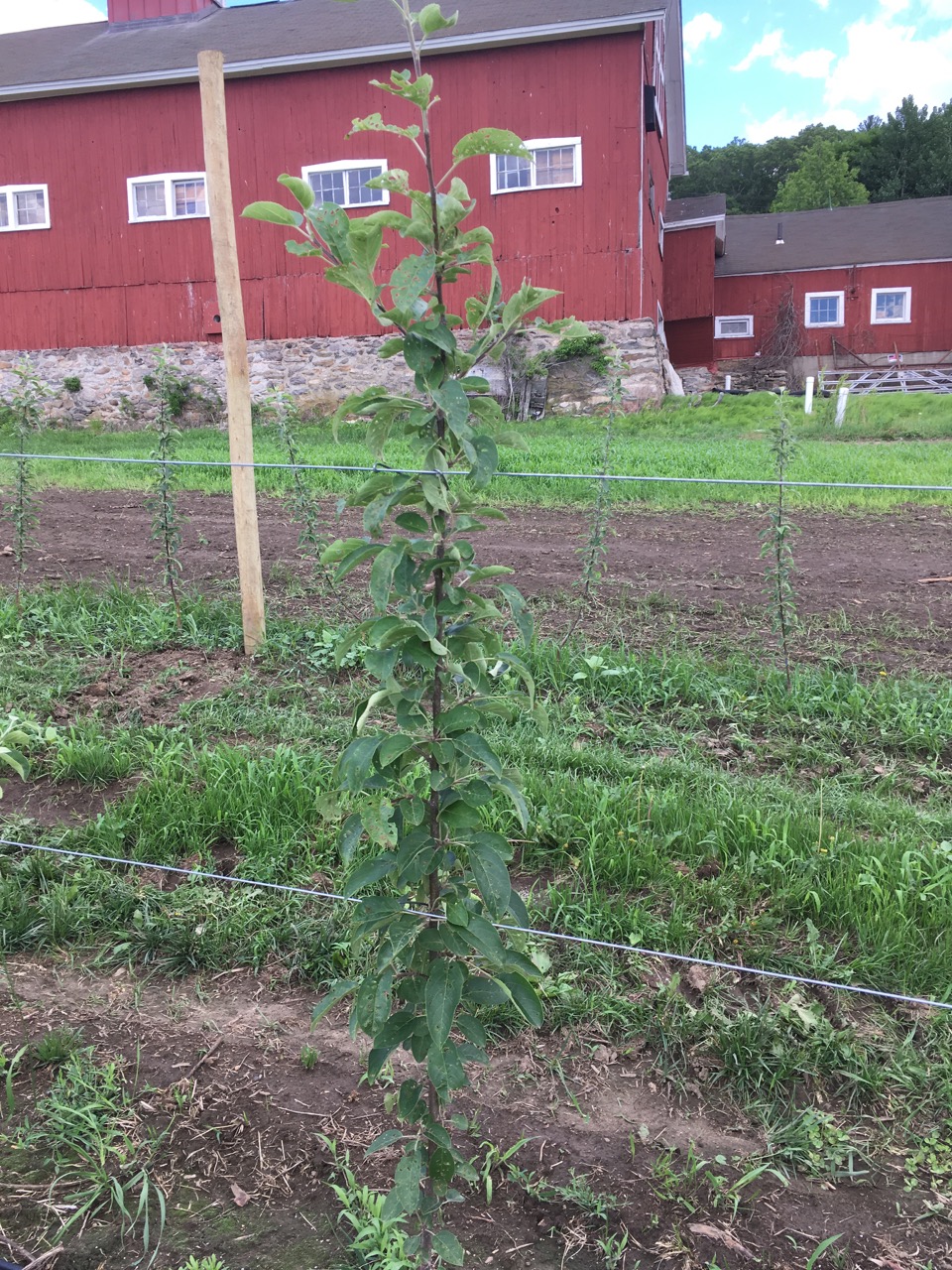 |
|
1st-leaf trees w/ no branches (whips) |
2nd-leaf trees treated with Maxcel 2016 |
2nd-leaf trees not treated (note lack of branching) |
Other hort tasks that should be ongoing include...
No Guest article this week...
Follow me (jmcextman) on FB: https://www.facebook.com/jmcextman
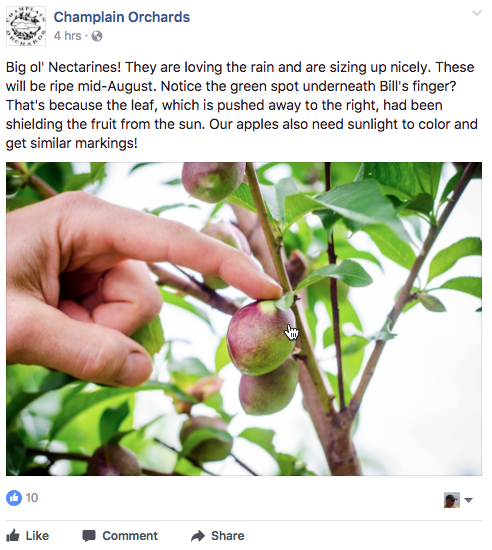
New England Tree Fruit Management Guide
UMass Fruit Advisor: http://umassfruit.com
Scaffolds Fruit Journal: http://www.nysaes.cornell.edu/ent/scafolds/
Network for Environment and Weather Applications (NEWA): http://newa.cornell.edu
Follow me on Twitter (http://twitter.com/jmcextman) and Facebook (http://www.facebook.com/jmcextman)
The next Healthy Fruit will be published on Tuesday, June 27 or thereabouts, 2017. (Maybe. I may be on Annual Leave next week too.) As always feel free to get in touch with any member of the UMass Fruit Team (http://extension.umass.edu/fruitadvisor/team-members) if you have questions or comments.